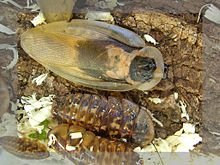Exopterygota
| Exopterygota Temporal range: Carboniferous–Recent
| |
|---|---|

| |
| Death's head cockroach or brown-winged Blaberus hybrid. Adult (above) and two immatures (note wing stubs) | |
| Scientific classification | |
| Domain: | Eukaryota |
| Kingdom: | Animalia |
| Phylum: | Arthropoda |
| Class: | Insecta |
| Infraclass: | Neoptera |
| Superorder: | Exopterygota |
| Orders | |
For extinct groups and possible future splits, see text. | |
The Exopterygota (
infraclass Neoptera, in which the young resemble adults but have externally developing wings. They undergo a modest change between immature and adult, without going through a pupal stage. The nymphs develop gradually into adults through a process of moulting.[1]
The Exopterygota are a highly diverse insect superorder, with at least 130,000 living species divided between 15
stick insects
, among many other types of insects.
They are distinguished from the
Aleyrodidae
).
damselflies
do) if at all.
Systematics
This section needs to be updated. The reason given is: "Exopterygota" is almost certainly considered paraphyletic by most phylogenetic studies in the last 10 years at least by now, as most of them instead recognise at least Polyneoptera and sometimes Paraneoptera (e.g. [2]), with the Paraneoptera more closely related to Holometabola than Polyneoptera.. (December 2023) |
Traditionally Exopterygota included all neopterans that show
paraphyletic
.
Here is a complete list of living and
extinct
orders of "exopterygotes", with some proposed subdivisions:
Superorder Exopterygota sensu stricto[citation needed]
- Caloneurodea (Extinct)
- Titanoptera (Extinct)
- Protorthoptera (Extinct)
- Plecoptera (stoneflies)
- Embioptera (webspinners)
- Zoraptera (angel insects)
- Dermaptera(earwigs)
- Orthoptera (grasshoppers, etc.)
Proposed superorder Dictyoptera
- Phasmatodea (stick insects – tentatively placed here)
- Grylloblattodea(ice-crawlers – tentatively placed here)
- Mantophasmatodea(gladiators – tentatively placed here)
- Blattodea (cockroaches and termites)
- Mantodea(mantids)
Proposed superorder Paraneoptera
- Psocoptera (booklice, barklice)
- Thysanoptera(thrips)
- lice)
- Hemiptera (true bugs)
References
- ^ a b "Division: Exopterygota". Amateur Entomologist's Society. Retrieved 31 October 2020.
- PMID 27558853.
